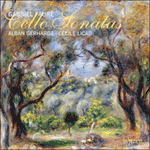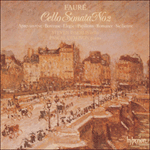
Welcome to Hyperion Records, a British classical label devoted to presenting high-quality recordings of music of all styles and from all periods from the twelfth century to the twenty-first.
Hyperion offers both CDs, and downloads in a number of formats. The site is also available in several languages.
Please use the dropdown buttons to set your preferred options, or use the checkbox to accept the defaults.

Like the Sicilienne, the Andante was taken from another project, and was in fact the nucleus from which the sonata grew. At the beginning of 1921, Fauré received a state commission to write a work for the ceremony to be held on 5 May at Les Invalides to mark the 100th anniversary of the death of Napoleon—not, one might have thought, much in his line, and he admitted to his wife that he found ‘the subject and the occasion thoroughly intimidating’. But he complied. And then the resulting Chant funéraire, duly orchestrated for the Garde républicaine by its conductor, obviously remained in its composer’s head. Would it never be heard again? He determined that it would. In the measured repeated chords of the accompaniment and the long majestic cello lines it looks back to the successful Élégie, now coloured with more enigmatic harmonies.
In the finale the two contrasting themes are separated in traditional fashion, the first a syncopated, almost jazzy tune, the second a tongue-in-cheek chorale. As in the First Sonata, the piano, playing in every bar of every movement, is the leader of things harmonic, while the cello rides imperiously over all its excentricities. In the variety and quality of his invention, the aged Fauré was every bit the equal of Verdi—or Elliott Carter. The day after the Sonata’s premiere on 13 May 1922, Vincent d’Indy wrote to his old friend: ‘I want to tell you that I’m still under the spell of your beautiful Cello Sonata … The Andante is a masterpiece of sensitivity and expression and I love the finale, so perky and delightful … How lucky you are to stay young like that!’
from notes by Roger Nichols © 2012
Comme la Sicilienne, l’Andante a été emprunté à un autre projet et est, en fait, le noyau dont a émergé la sonate. Au début de l’année 1921, Fauré a reçu une commande de l’État pour écrire une œuvre destinée à la cérémonie qui devait se dérouler le 5 mai aux Invalides à l’occasion du centenaire de la mort de Napoléon—ce qui, pourrait-on penser, n’était pas vraiment son genre; «Ce n’est pas sans être fortement intimidé par le sujet et par la circonstance» a-t-il avoué à sa femme. Mais il s’est exécuté et le résultat, le Chant funéraire, dûment orchestré pour la Garde républicaine par son chef d’orchestre, lui est évidemment resté dans la tête. Serait-il à nouveau exécuté? Il décida que ce serait le cas. Dans les accords répétés et mesurés de l’accompagnement et les longues et majestueuses lignes du violoncelle, il retrouve la réussite de l’Élégie, maintenant colorée d’harmonies plus énigmatiques.
Dans le finale, les deux thèmes contrastés sont séparés de manière traditionnelle, le premier un air syncopé, qui a presque le caractère du jazz, le second un choral au deuxième degré. Comme dans la Première Sonate, le piano, qui joue tout au long de l’œuvre, à chaque mesure de chaque mouvement, mène ce qui est harmonique, alors que le violoncelle survole impérieusement toutes ses excentricités. Dans la diversité et la qualité de son invention, Fauré dans son grand âge était à tout point de vue l’égal de Verdi—ou d’Elliott Carter. Le lendemain de la création de cette sonate le 13 mai 1922, Vincent d’Indy a écrit à son vieil ami: «Je veux te dire combien je suis encore sous le charme de ta si belle Sonate de violoncelle … Ton Andante est un vrai chef-d’œuvre de sensibilité expressive, et j’aime infiniment le final, si alerte et si prenant … Ah, tu as de la veine de rester jeune comme ça!»
extrait des notes rédigées par Roger Nichols © 2012
Français: Marie-Stella Pâris
Ebenso wie die Sicilienne stammte das Andante aus einem anderen Projekt und wurde dann sogar der Kern, aus dem die Sonate erwuchs. Zu Beginn des Jahres 1921 erhielt Fauré den Auftrag von der französischen Regierung, ein Werk für die Zeremonie am 5. Mai in Les Invalides anlässlich des 100. Todestages Napoleons zu komponieren—nicht unbedingt ein Projekt in Faurés Sinne, könnte man meinen, und tatsächlich gab er seiner Frau gegenüber zu, dass er „Thema und Anlass durchaus einschüchternd“ fand. Doch erfüllte er den Auftrag. Und der daraus resultierende Chant funéraire, der für die Garde républicaine ordnungsgemäß von ihrem Dirigenten orchestriert wurde, ging ihm offenbar nicht aus dem Sinn. Sollte das Stück je wieder zu hören sein? Er sorgte dafür, dass das geschehen würde. Mit den bedächtigen Akkordrepetitionen in der Begleitstimme und den langen majestätischen Linien des Cellos blickt das Werk auf die erfolgreiche Élégie zurück, doch erklingen hier noch verrätseltere Harmonien.
Im Finale treten die beiden Themen—das erste eine synkopierte, fast jazzartige Melodie; das zweite ein ironisch anmutender Choral—traditionsgemäß voneinander getrennt auf. Ebenso wie in der Ersten Sonate ist das Klavier, das in allen Takten der drei Sätze des Werks spielt, die harmonische Leitstimme, während das Cello gebieterisch über alle Exzentrizitäten hinweggleitet. Was die Vielfalt und Qualität seiner musikalischen Eingebung anbelangt, so war Fauré im Alter Verdi—oder auch Elliott Carter—mindestens ebenbürtig. Am Tag nach der Uraufführung der Sonate, die am 13. Mai 1922 stattgefunden hatte, schrieb Vincent d’Indy an seinen alten Freund: „Ich wollte dir sagen, wie sehr ich mich noch im Bann deiner wunderschönen Sonate für Violoncello befinde … Dein Andante ist ein wahres Meisterwerk an ausdrucksvoller Empfindsamkeit, und mir gefällt auch das Finale sehr, so lebendig und packend … Hast du ein Glück, so jung zu bleiben!“
aus dem Begleittext von Roger Nichols © 2012
Deutsch: Viola Scheffel
 Fauré: Cello Sonatas Fauré: Cello SonatasAlban Gerhardt and Cecile Licad perform two masterpieces of the cello sonata repertoire—those by Fauré, remarkably written when he was in his seventies—alongside some of his most seductive bon-bons, including the wistful Sicilienne and the heartfe ...» More |
 Fauré: Cello Sonata No 2 & other works Fauré: Cello Sonata No 2 & other works‘A lovely disc’ (The Independent)» More |

